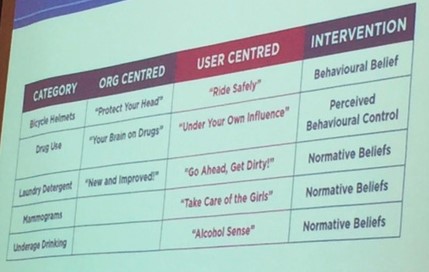At its core, public relations are about storytelling and now more than ever brands need to have a powerful and compelling story to engage and mobilize their audiences.
The trouble is, storytelling has its limitations. In today’s saturated communications marketplace, where information is digested in smaller sizes and competing against more channels, the ability for a story to engage and retain an audience is becoming increasingly difficult. Furthermore, technology has expanded the ability of audiences to digest information, so brands must find a more meaningful means to deliver a coherent and credible message.
Moving beyond storytelling
Brands today must move beyond segmented campaigns and episodic storytelling and develop a narrative, an central thematic that is the basis of the brand’s identity and strategy. A foundational idea that encompasses and forms all areas of a brand’s engagement across its myriad of channels and stakeholders, be it employees; consumers, traditional media, social influencers, policy makers, etc. A company’s narrative should tell everyone what it stands for and offers an idea for those stakeholders to connect with and align behind.
Today, public relations, corporate relations, publicists and marketers are all competing to engage the same audiences through more integrated means – paid, earned, social and owned – meaning that messaging needs to be not only engaging but also consistent across the various streams, and most important of all, in real time.
Brands must lead conversations
Digital and social media platforms have changed the way brands engage with their audiences. Communication no longer flows in a single direction; audiences are now feeding back to companies on a constant basis. Brands must now lead “conversations”, interacting with their audiences in real time, which has quantifiable impact on their reputation.

Proactively driving engagement is now an absolute. While engaging with audiences across these various channels, brands need to utilize a coherent narrative, one that provides clarity and consistency of that engagement. The ability to communicate a compelling, inclusive and consistent narrative has the power to inspire, energize and mobilize an audience in ways our industry never thought possible.
How to develop a strong narrative
- Have a real understanding of the brand’s purpose and its values. Consumers today are more value driven than ever before. How a company is trying to achieve its objective, is as important as what it is trying to achieve. Ensure your narrative seeks to explain what the brand stands for and what is it is seeking to achieve.
- The narrative must be relatable and easy to explain. To maintain the attention of audiences, a narrative cannot be bogged down in jargon. A strong narrative is based on fact and is not only persuasive but also easily repeatable.
- Be inclusive and insightful. Narratives need to evoke an emotional connection and invite participation. It presents an idea for an audience to believe in, support, and ultimately recommend.
In our hyper-completive, over-saturated communications environment, being able to portray a potent and authentic narrative has the power to genuinely connect with an audience, inspire them to action, and lead them on a journey.
Tags: brand engagement, branding, business, marketing, Media relations vancouver, Public relations, Vancouver PR, Vancouver social media
This year’s BCAMA annual marketing agency panel did not disappoint. Expert speakers from top agencies provided a strong sense of what’s to come this year and created a healthy debate around what’s really going to be some of the key drivers. There was a ton of information relayed to the hundreds of branding and communications professionals in the audience. Here are few of the highlights we took away with us.

Speaker #1: Andrew McCarthy – President, Tribal Worldwide Canada
The theme of Andrew’s presentation was around using content to connect with consumers. Research has recently shown that 71% of consumers who have blocked ads have said they’d consider whitelist advertising if the content was decent. Basically, people hate bad advertising.
So, how do you increase the shareability of your content?
- Relatability – your content must be relevant
- Have a point of view – this will help streamline content and ensure it’s consistent and interesting
- Findability – search rankings are key when it comes to content dissemination
- Mobility – make sure your content is where your audience is hanging out
- Likeability – it’s an obvious one but your audience has to want to genuinely share your content
Snack Time, the milk producers of Western Canada’s cartoon series, was shared as a successful campaign where all the above was put in motion.
Speaker #2 Kelly Stephenson – Director of Strategy, Creature Agency, Seattle
Kelly’s talk centred around the prediction that there will be a rebalance between data and “creative bravery”. Kelly acknowledged the importance of data but cautioned that often marketers can get so caught up in data that the ability to connect with consumers is lost. Her argument around brands not becoming too obsessed with data was effectively summarised when she said, “data looks backwards; insights look forwards.” Marketers need to consider data and use this to create consumer insights in order to produce relevant and creative narratives that will increase the value of the relationship between brand and consumer.
An example used to highlight this argument was REI and its decision to shut up shop for the day on Black Friday and encourage its followers to #optoutside. REI chose to prioritize its shared values with its Millennial audience, putting a short-term need (a lot of revenue on Black Friday) behind the longer-term relationship. It was a smart move as the retailer generated millions of media impressions and a significant amount of content and engagement around #optoutside.
Speaker #3 April Yao – Senior Account Manager, 6S Marketing & Sheng Li Digital
April got up on stage and immediately said she had to disagree with some of Kelly’s points as 6S still uses and responds to data to ensure successful client campaigns that are closely tracked and clearly show ROI. April primarily presented on two topics: retargeting (also known as remarketing) and marketing to the Chinese population. April discussed the virtues of retargeting and dynamic remarketing (getting specific products that someone has already looked at on your brand website in front of the user when they are viewing another site). She said that, if you follow the cost per click (CPC) model, you’ll see the value quickly.
On the Chinese front, April said that approx. 20% of the Vancouver population is Chinese and encouraged the marketers in the room not to forget this growing market which often has high spending power. She talked about some of the equivalent Chinese social sites such as Youku (video), Baidu (search), and Weibo (think Twitter and micro-blogging).
April gave the example of Cirque du Soleil and how they were selling tickets fast in the English-speaking Vancouver community but not in the Chinese community. Through a Weibo contest, creating a Chinese landing page and a retargeting campaign, Cirque saw a significant increase in its ticket sales. Her final point on this community was that ethnic markets shouldn’t be forgotten but they also require their own distinct strategy.
Speaker #4 Dan Scherk – Partner & Creative Director, Traction Creative
Finally, Dan Scherk took to the stage to discuss the importance of brands adopting a user-centric approach in their marketing campaigns. He talked about how social marketing in particular has proven how brands cannot be organization-centric and that they have to prioritize user needs. Using his psychology background, he delved into social marketing behavioural theories and touched upon reasoned action approach, a benchmark for understanding and predicting human behaviour. Dan emphasised the need for marketers to tap into consumers’ beliefs, showing how that would impact attitudes which would in turn formulate intentions and lead onto certain behaviours.
 The last case study of the morning was an interesting one: it was the “Dumb Ways to Die” campaign that was launched by Metro in Melbourne, Victoria. The cartoon campaign series was focused on reducing the number of accidents on its trains. Based on this, it was extremely successful and resulted in a 20% reduction in accidents. The campaign won top industry awards and was hailed a great success by many. But it was viewed as a failure by others. Why? In the real world, the true issue was suicide. So, a successful user-centred approach would have been around suicide prevention. Instead, the brand took an organizational approach and focused on an issue that was not the real problem.
The last case study of the morning was an interesting one: it was the “Dumb Ways to Die” campaign that was launched by Metro in Melbourne, Victoria. The cartoon campaign series was focused on reducing the number of accidents on its trains. Based on this, it was extremely successful and resulted in a 20% reduction in accidents. The campaign won top industry awards and was hailed a great success by many. But it was viewed as a failure by others. Why? In the real world, the true issue was suicide. So, a successful user-centred approach would have been around suicide prevention. Instead, the brand took an organizational approach and focused on an issue that was not the real problem.
Finally, the panel moderator, Claire Booth of Lux Insights, said that, while #FOMO (fear of missing out) was a real thing last year, this year, it’s apparently going to be all about #FOLO (fear of living offline).
Tags: bcama, featured, marketing, media relations, Peak Communicators
People often think of public relations only in marketing terms. How can we use PR to build our brand? If they don’t see an immediate payoff, they ask why bother? They are missing the link between positive PR and saving the brand during a crisis. Positive PR is like getting a flu shot, it won’t guarantee you don’t get the bad news flu, but it will make the symptoms less severe.
When a crisis hits, the first step reporters take is to type your name and your company’s name into Google. They are looking for a general impression. What another reporter has said about you will be given a great deal of weight. Reporters trust other reporters above all others.
Step two for a reporter is to search your name and the key crisis words like “fire,” “layoffs” or “complaints,” whatever best describes the crisis. They are looking for how you handled previous events and if there are any stories about your preparedness or lack thereof.
They will search all your social media channels, personal and corporate. They will dig hard and they are really good at it.
Within a few minutes they will form a picture of your corporate or personal character and that will frame an approach to the story in the hours, days, or weeks ahead. It is a picture you will find very hard to change during a crisis. For media there is no grey. It’s black and white, you are the good guy or the bad guy, the victim or the perpetrator.
 Try it right now. Search your name, your company’s name. Now search again and add in a crisis word or two. See what comes up. That’s what a reporter will know about you today if bad news strikes in the next few minutes. If you have been keeping a low profile, not telling your positive stories, then reporters will find a void. This void will be filled with bad news when disaster strikes. Your bad news flu just became pneumonia. It might be fatal.
Try it right now. Search your name, your company’s name. Now search again and add in a crisis word or two. See what comes up. That’s what a reporter will know about you today if bad news strikes in the next few minutes. If you have been keeping a low profile, not telling your positive stories, then reporters will find a void. This void will be filled with bad news when disaster strikes. Your bad news flu just became pneumonia. It might be fatal.
The most overlooked component to effective crisis management is building a positive public reputation in advance of any crisis. You can’t control when a crisis will strike but you can control how you build your reputation in advance of the bad news. This reputation will be the foundation you stand on during the crisis. Create a public perception of your company as a positive member of the community. It will help shape how media and the public will view the crisis story and your efforts to deal with it.
There is an old saying in politics, “If you don’t define yourself, your opponents will define you.” Business is no different. If you don’t define yourself now, the media, your critics or the crisis will do it for you.
 An organization with a good public reputation will take a hit but will weather the crisis better than one that the public first hears about when a crisis has struck and the blame game is in full swing.
An organization with a good public reputation will take a hit but will weather the crisis better than one that the public first hears about when a crisis has struck and the blame game is in full swing.
Now is the time to get your bad news flu shot.
Tags: brand, crisis communications, marketing, personal brand, Public relations, social media
 Building a company image or brand profile is no easy task: competition is tough and consumers are sales-savvy and cynical. While it’s natural for companies to want to promote their product or service, some methods are more effective than others.
Building a company image or brand profile is no easy task: competition is tough and consumers are sales-savvy and cynical. While it’s natural for companies to want to promote their product or service, some methods are more effective than others.
As an independent public relations agency, we act as the extended arm for many in-house marketing teams. Though we have a common goal of increasing exposure and building a positive public image for the company, we often go about it a slightly different way.
Typically, we hunt out and share a company story or concept that appeals to a broad audience that could include journalists, potential customers, industry experts, researchers and even competitors.
This often means taking an idea, a thought or an industry trend that, while relevant, is one step removed from the company’s product or service, and holds greater meaning to more people. Such content may come in the form of a media articles, research trends or blogs, and will:
- Have broader relevance
- Allow more people to relate to the topics discussed
- Back up all claims
- Avoid promoting a single product or service
- Potentially draw upon credible research
- Leverage a trending school of thought
Most importantly, this content will appeal to journalists who’re seeking objective, informative and digestible stories to keep their readers coming back for more.
Sounds simple enough, right?
Perhaps in theory. However, we’re frequently faced with the challenge of striking a balance between creating informative stories that attract diverse readership, and elevating a company’s product or service to target potential customers. What pleases a journalist commonly will not appeal to a brand ambassador.
So how do we manage this predicament?
According to Marketo’s recent market research and Content Marketing vs. Traditional Advertising info-graphic, sharing media articles is one of the mosteffective content marketing strategies—in fact, it is ranked a close second behind social media out of all available marketing tactics.
 Based on these findings, and in our experience, there has never been a better time for companies to expand their reach via original, objective and compelling content that resonates with journalists and is likely to be published.
Based on these findings, and in our experience, there has never been a better time for companies to expand their reach via original, objective and compelling content that resonates with journalists and is likely to be published.
Once published, not only will the coverage become an invaluable asset for the marketing toolkit, and boost the company’s SEO via high-quality inbound links, it will demonstrate to both potential and current customers that the company has a vested interest in thought-leadership and contributing to its industry—not merely boosting the bottom line.
In our opinion, any well-rounded marketing and communications plan should include quality journalism and media coverage that appeals beyond the company’s immediate audience—thinking broader produces bigger results.
Tags: advertising, content creation, content marketing, journalists, marketing, SEO







 Based on these findings, and in our experience, there has never been a better time for companies to expand their reach via original, objective and compelling content that resonates with journalists and is likely to be published.
Based on these findings, and in our experience, there has never been a better time for companies to expand their reach via original, objective and compelling content that resonates with journalists and is likely to be published.